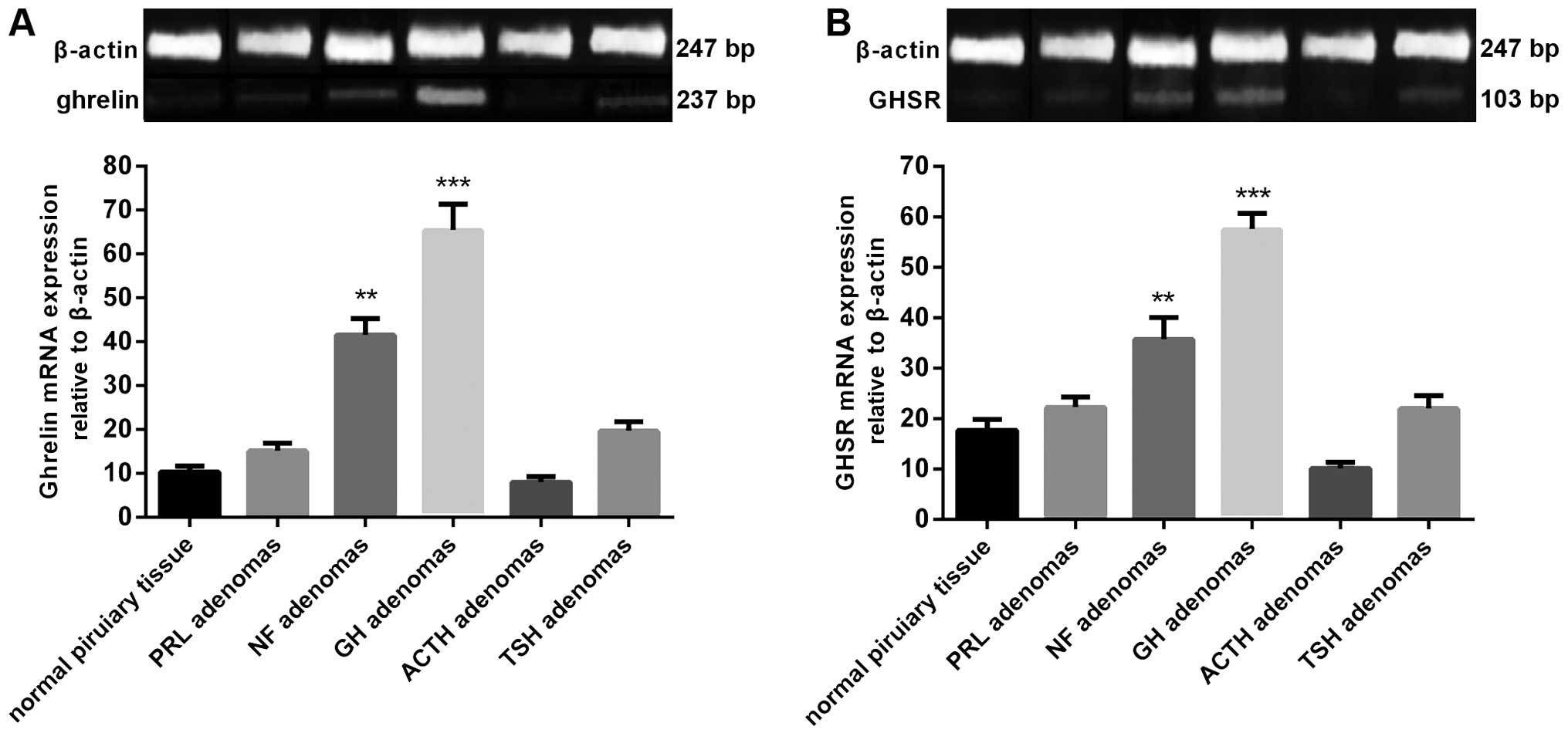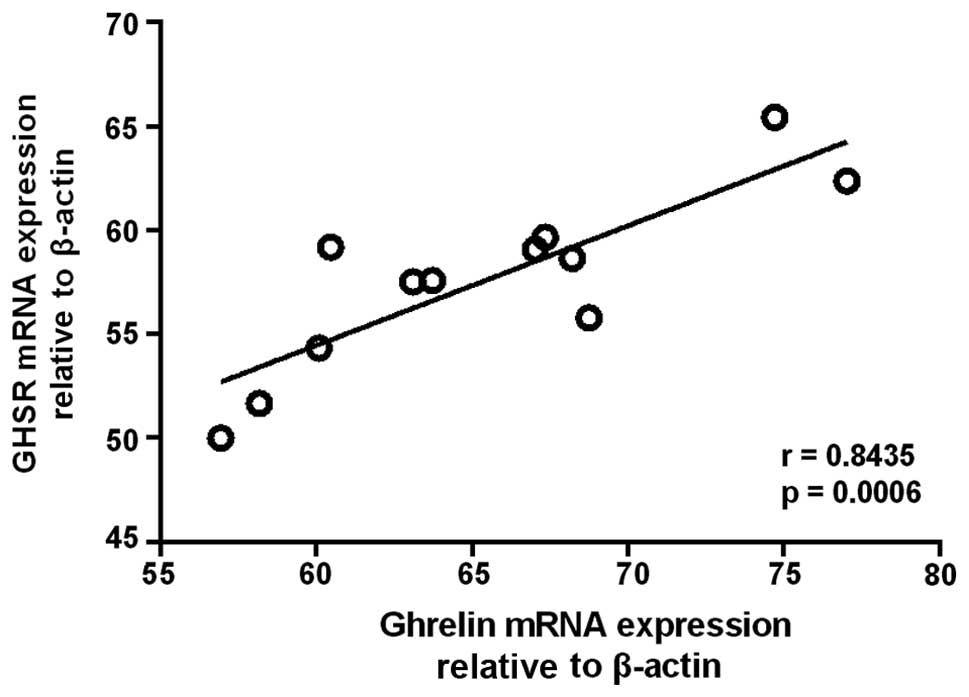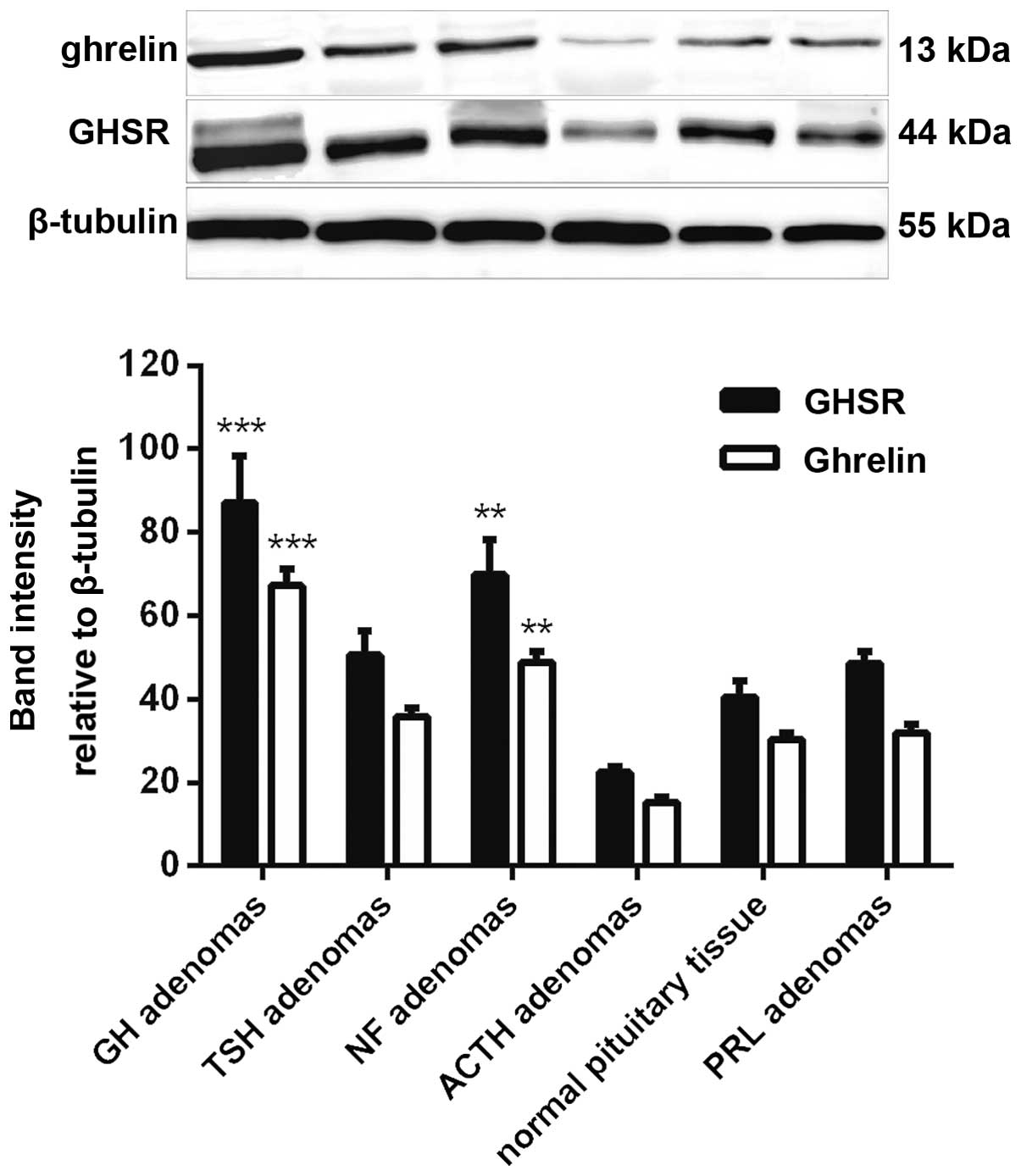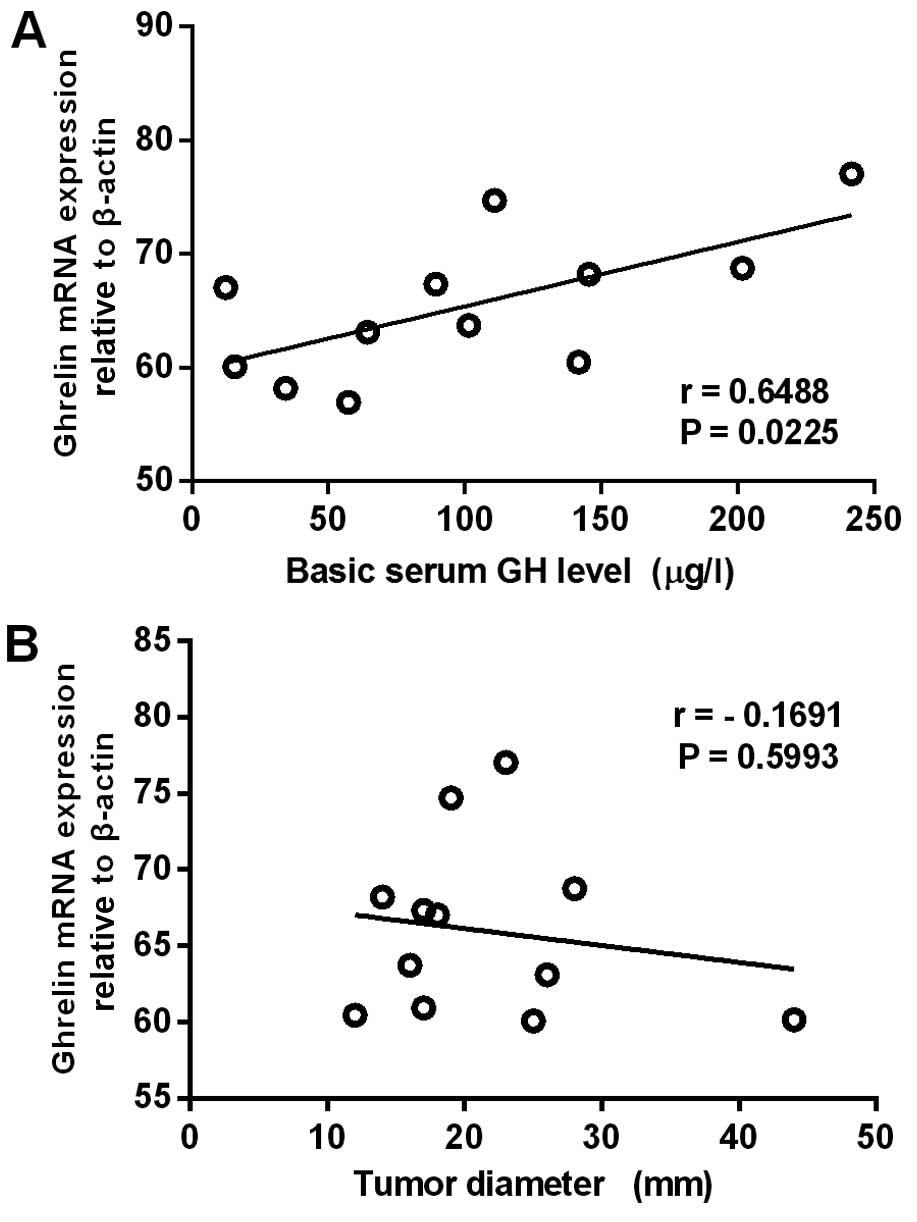|
1
|
Chopin L, Walpole C, Seim I, et al:
Ghrelin and cancer. Mol Cell Endocrinol. 340:65–69. 2011.
View Article : Google Scholar : PubMed/NCBI
|
|
2
|
Honda K, Bailey AR, Bull PM, Macdonald LP,
Dickson SL and Leng G: An electrophysiological and morphological
investigation of the projections of growth hormone-releasing
peptide-6-responsive neurons in the rat arcuate nucleus to the
median eminence and to the paraventricular nucleus. Neuroscience.
90:875–883. 1999. View Article : Google Scholar : PubMed/NCBI
|
|
3
|
Kim K, Arai K, Sanno N, Osamura RY,
Teramoto A and Shibasaki T: Ghrelin and growth hormone (GH)
secretagogue receptor (GHSR) mRNA expression in human pituitary
adenomas. Clin Endocrinol. 54:759–768. 2001. View Article : Google Scholar
|
|
4
|
Howard AD, Feighner SD, Cully DF, et al: A
receptor in pituitary and hypothalamus that functions in growth
hormone release. Science. 273:974–977. 1996. View Article : Google Scholar : PubMed/NCBI
|
|
5
|
Chu S and Schubert ML: Gastric secretion.
Curr Opin Gastroenterol. 29:636–641. 2013. View Article : Google Scholar : PubMed/NCBI
|
|
6
|
Skinner MM, Nass R, Lopes B, Laws ER and
Thorner MO: Growth hormone secretagogue receptor expression in
human pituitary tumors. J Clin Endocrinol Metab. 83:4314–4320.
1998. View Article : Google Scholar : PubMed/NCBI
|
|
7
|
Korbonits M, Bustin SA, Kojima M, et al:
The expression of the growth hormone secretagogue receptor ligand
ghrelin in normal and abnormal human pituitary and other
neuroendocrine tumors. J Clin Endocrinol Metab. 86:881–887. 2001.
View Article : Google Scholar : PubMed/NCBI
|
|
8
|
Kim K, Sanno N, Arai K, et al: Ghrelin
mRNA and GH secretagogue receptor mRNA in human GH-producing
pituitary adenomas is affected by mutations in the alpha subunit of
G protein. Clin Endocrinol (Oxf). 59:630–636. 2003. View Article : Google Scholar : PubMed/NCBI
|
|
9
|
Knosp E, Steiner E, Kitz K and Matula C:
Pituitary adenomas with invasion of the cavernous sinus space: a
magnetic resonance imaging classification compared with surgical
findings. Neurosurgery. 33:610–617. 1993. View Article : Google Scholar : PubMed/NCBI
|
|
10
|
Korbonits M, Kojima M, Kangawa K and
Grossman AB: Presence of ghrelin in normal and adenomatous human
pituitary. Endocrine. 14:101–104. 2001. View Article : Google Scholar : PubMed/NCBI
|
|
11
|
Stevanović D, Milosević V, Starcević VP
and Severs WB: The effect of centrally administered ghrelin on
pituitary ACTH cells and circulating ACTH and corticosterone in
rats. Life Sci. 80:867–872. 2007. View Article : Google Scholar : PubMed/NCBI
|
|
12
|
Giraldi Pecori F, Bucciarelli LG, Saccani
A, et al: Ghrelin stimulates adrenocorticotrophic hormone (ACTH)
secretion by human ACTH-secreting pituitary adenomas in vitro. J
Neuroendocrinology. 19:208–212. 2007. View Article : Google Scholar
|
|
13
|
Rau TT, Sonst A, Rogler A, et al: Gastrin
mediated down regulation of ghrelin and its pathophysiological role
in atrophic gastritis. J Physiol Pharmacol. 64:719–725.
2013.PubMed/NCBI
|
|
14
|
Bowers CY, Momany FA, Reynolds GA and Hong
A: On the in vitro and in vivo activity of a new synthetic
hexapeptide that acts on the pituitary to specifically release
growth hormone. Endocrinology. 114:1537–1545. 1984. View Article : Google Scholar : PubMed/NCBI
|
|
15
|
Korbonits M and Grossman AB: Growth
hormone-releasing peptide and its analogues Novel stimuli to growth
hormone release. Trends Endocrinol Metab. 6:43–49. 1995. View Article : Google Scholar : PubMed/NCBI
|
|
16
|
Smith RG, Van der Ploeg LH, Howard AD, et
al: Peptidomimetic regulation of growth hormone secretion. Endocr
Rev. 18:621–645. 1997. View Article : Google Scholar : PubMed/NCBI
|
|
17
|
Rotondo F, Cusimano M, Scheithauer BW,
Rotondo A, Syro LV and Kovacs K: Ghrelin immunoexpression in
pituitary adenomas. Pituitary. 14:318–322. 2011. View Article : Google Scholar : PubMed/NCBI
|
|
18
|
Rak-Mardyla A: Ghrelin role in
hypothalamus-pituitary-ovarian axis. J Physiol Pharmacol.
64:695–704. 2013.PubMed/NCBI
|
|
19
|
Nanzer AM, Khalaf S, Mozid AM, et al:
Ghrelin exerts a proliferative effect on a rat pituitary
somatotroph cell line via the mitogen-activated protein kinase
pathway. Eur J Endocrinol. 151:233–240. 2004. View Article : Google Scholar : PubMed/NCBI
|
|
20
|
Avau B, De Smet B, Thijs T, et al: Ghrelin
is involved in the paracrine communication between neurons and
glial cells. Neurogastroenterol Motil. 25:e599–608. 2013.
View Article : Google Scholar : PubMed/NCBI
|
|
21
|
Yu H, Xu G and Fan X: The effect of
ghrelin on cell proliferation in small intestinal IEC-6 cells.
Biomed Pharmacother. 67:235–239. 2013. View Article : Google Scholar : PubMed/NCBI
|
|
22
|
Tian C, Zhang L, Hu D and Ji J: Ghrelin
induces gastric cancer cell proliferation, migration, and invasion
through GHS-R/NF-κB signaling pathway. Mol Cell Biochem.
382:163–172. 2013. View Article : Google Scholar : PubMed/NCBI
|
|
23
|
Tian C, Ye F, Wang L, et al: Nitric oxide
inhibits ghrelin-induced cell proliferation and ERK1/2 activation
in GH3 cells. Endocrine. 38:412–416. 2010. View Article : Google Scholar : PubMed/NCBI
|
|
24
|
Cassoni P, Papotti M, Ghè C, et al:
Identification, characterization, and biological activity of
specific receptors for natural (ghrelin) and synthetic growth
hormone secretagogues and analogs in human breast carcinomas and
cell lines. J Clin Endocrinol Metab. 86:1738–1745. 2001. View Article : Google Scholar : PubMed/NCBI
|
|
25
|
Xu Y, Pang X, Dong M, Wen F and Zhang Y:
Ghrelin inhibits ovarian epithelial carcinoma cell proliferation in
vitro. Oncol Rep. 30:2063–2070. 2013.PubMed/NCBI
|
|
26
|
Jeffery PL, Murray RE, Yeh AH, et al:
Expression and function of the ghrelin axis, including a novel
preproghrelin isoform, in human breast cancer tissues and cell
lines. Endocr Relat Cancer. 12:839–850. 2005. View Article : Google Scholar : PubMed/NCBI
|
|
27
|
Grönberg M, Fjällskog ML, Jirström K and
Janson ET: Expression of ghrelin is correlated to a favorable
outcome in invasive breast cancer. Acta Oncol. 51:386–393. 2012.
View Article : Google Scholar : PubMed/NCBI
|



















